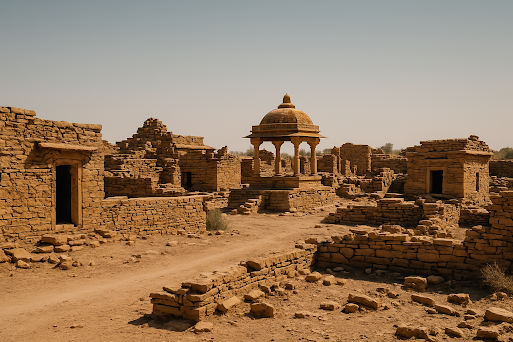Chand Baori – India’s Deepest Stepwell and Its 1,200-Year-Old Geometric Wonder
📍 Abhaneri, Rajasthan | 🕰️ 8th–9th Century | 🪔 3,500 Steps | 📏 100 Feet Deep
When travelers think of Rajasthan, they imagine golden forts, camel rides, and bustling bazaars. But hidden in the quiet village of Abhaneri, 95 km from Jaipur, lies an ancient marvel that defies time—Chand Baori, one of India’s largest, deepest, and most hypnotic stepwells.
1. History: Who Built Chand Baori?
-
Constructed during the 8th–9th century by King Chanda of the Nikumbh Rajput dynasty, this marvel was built to conserve water and act as a community hub in dry, desert conditions.
-
Though exact dating is debated, its design closely resembles nearby temples from the same era.
-
The neighboring Harshat Mata Temple, believed to be built around the same time, suffered destruction during Mahmud Ghazni’s invasions and later Mughal interference.
Fun Fact: Chand Baori follows the Vastu Shastra concept of Vijay Vapi, a sacred geometric style meant to retain energy and water balance.
2. The Architecture: A Staircase to Another World
It’s not just a stepwell—it’s a mathematical masterpiece:
-
✅ 13 Stories Deep — Plunges about 100 feet (30 meters) underground.
-
✅ 3,500 Symmetrical Steps — Crafted in a precise inverted pyramid that creates an almost optical illusion from every angle.
-
✅ Three Sides of Steps — The fourth side hosts royal pavilions and arcaded galleries with decorative sculptures.
-
✅ Cooling Effect — Its depth and stone construction ensure the bottom stays 5–6°C cooler than the surface.
Why So Precise?
Beyond water storage, stepwells like Chand Baori were places for spiritual reflection, social gatherings, and rituals, making symmetry vital for both functionality and sacred geometry.
3. The Harshat Mata Temple: Ruins of Joy
Situated beside Chand Baori, this ancient temple was dedicated to Harshat Mata, the goddess of joy. Though in ruins today, you’ll still find:
-
Statues of Durga, Mahishasura Mardini, and Vishnu avatars
-
Celestial motifs and partial fresco remains
-
Architectural alignment that reflects a sacred connection between water and divinity
4. Myths & Mysteries of Chand Baori
-
❌ The "Secret Tunnel" to Dausa – Local legends whisper of an escape tunnel, but no physical evidence exists.
-
👑 Royal Ceremonial Use – The palatial pavilions hint at its use for rituals or royal rest.
-
🎬 Hollywood & Bollywood – Chand Baori’s hypnotic geometry inspired the prison pit in The Dark Knight Rises. Actual films shot here include:
-
The Fall (2006)
-
Bhool Bhulaiyaa (2007)
-
5. Visiting Chand Baori: A Traveler’s Guide
🧭 Location: Abhaneri village, Dausa district – 95 km from Jaipur, on the Jaipur–Agra highway (NH21).
📅 Best Time to Visit:
-
October to March (avoid April–June due to intense heat)
📸 Photography Tips:
-
Morning: Diagonal shadows enhance the geometric effect
-
Noon: Best time for symmetrical overhead shots
🎟️ Entry Fee: Free (Archaeological Survey of India maintained)
🚫 Restrictions: No swimming; access beyond a certain point is restricted for safety.
Final Thoughts: Why Chand Baori is a Must-See
Chand Baori isn’t just another stop on a tourist map—it’s a living relic of engineering, art, and devotion. It embodies a 1,200-year-old story of how our ancestors mastered architecture to meet both spiritual and survival needs.
Perfect for:
-
🏛️ History Buffs
-
📐 Architecture Nerds
-
📷 Photographers
-
💎 Hidden Gem Hunters
Pro Tip: Pair your visit with Bhangarh Fort (just 50 km away) for a full day of legends and ruins.




Comments
Post a Comment